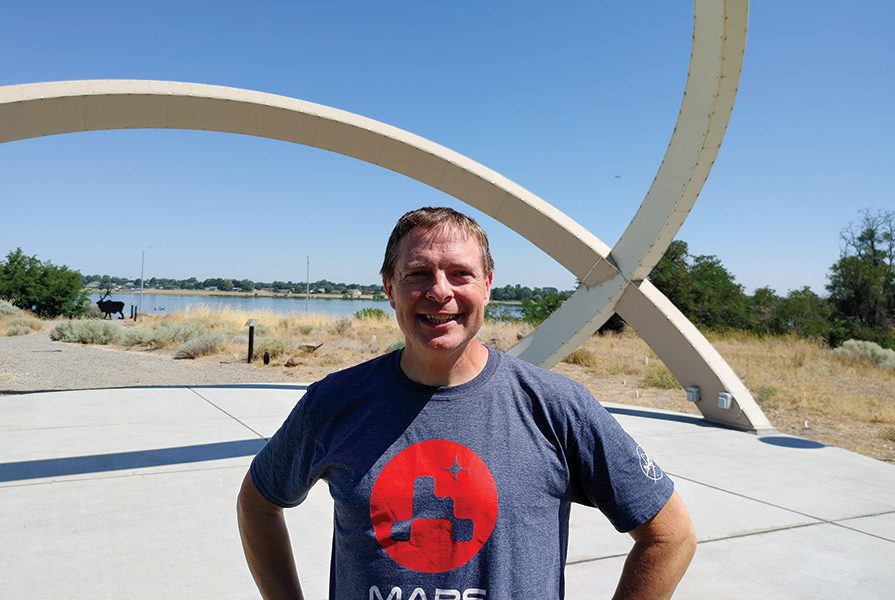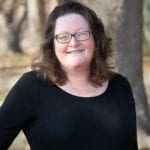
Home » Cities embrace space when the solar system comes to town
Cities embrace space when the solar system comes to town

August 11, 2022
Mid-Columbia is being transformed into an 80-mile scaled replica of the solar system, one planetary orbit at a time.
The ambitious project promotes science education and tourism by placing orbital markers representing each of the nine major planets (Pluto is included) in orbit around a 40-foot sculpture of the sun at the Reach Museum in Richland.
It is no small thing.
The scaled distance between the sun and Pluto is about 40 miles (and an average of 3.7 billion miles in reality.) At that scale, Pluto’s elliptical orbit passes near Sunnyside, Othello, White Bluffs, Prescott, Stanfield and Boardman.
Decades in making
The Hanford Reach Solar System is the brainchild of Trevor Macduff, a Richland science teacher who began thinking about a regional model solar system during a professional development program more than 20 years ago.
It began taking shape in 2011 when he was part of the Three Rivers HomeLink team building a STEM program. It was looking for big projects that would engage students. He laughs now, but at the time, he thought it would take two years to get the word out and get the project built.
It took time, but he eventually found takers in Richland, which at the time was preparing to build the Reach Museum on a spot overlooking the Columbia River and Bateman Island at the Wye.
Based on his scale, the sun would be at the Reach and Pluto would be at the White Bluffs Boat Launch.
Setting the sun
The sun, consisting of a pair of 40-foot arches oriented north-south, was installed on the lawn with its own stage. It has proved a popular spot for weddings and other gatherings. It was even briefly a gathering place for homeless people during the pandemic, until officials turned off the power.

Once the sun was in place, Macduff began looking to install markers along the walking trails of Kennewick, Pasco and Richland. The paths extend away from the sun and are well traveled, making them accessible to visitors.
Earth’s marker is about a mile away, near the Wye boat launch, in keeping with the scaled distance. Mars and Venus haven’t come into being, but there’s a marker for Jupiter at the north end of Richland’s Howard Amon Park and for Saturn at the USS Triton Sail Park, overlooking the river in north Richland near the Port of Benton.
He’s working to secure permission from the Army Corps of Engineers to install similar markers in Kennewick and Pasco, where the federal agency controls what can be installed along the waterfronts.
Benton City installed Uranus in 2021. Prosser expects to install Neptune by September.
Macduff welcomes duplication. If West Richland wants a Saturn, that’s great.
The planet’s orbit passes through Leona Libby Middle School and near Yoke’s Fresh Market. Macduff is amenable to fudging locations slightly if it means putting markers in spots where they can be visited and not in anonymous locations hidden in fields.
“If you have 10 Jupiters or six Plutos, you get a flavor for what the orbits look like,” he said.
Each orbital marker involves a basalt base with Corten steel arches and an explanatory plaque in stainless steel. Sites are donated and it costs about $5,000 to install each marker.
His students teamed up with artists to design sculptures representing each planet. He asked his students to contemplate what sets each planet apart. He remembers students drawing a blank for Earth, then settling on DNA, which was incorporated into the statue design.
“It was pleasantly impressive to see all the great ideas,” he said.
The pandemic slowed but did not halt the work. Macduff expected to start from the sun and work his way out with markers at intervals along the riverfront walkways of Richland, Kennewick and Pasco.
Leaning into Uranus
He anticipated approaching Benton City, which is in the orbital path of the ice giant Uranus, with some dread.
Uranus, for the Greek sky god Ouranos, is pronounced with a short “a,” sound, or yur-a-nus.
Macduff spent enough time with middle schoolers to know it would inevitably get the long “a” treatment and be pronounced like the body part, “your-anus.”
Macduff gave a presentation at a Rotary meeting and met Benton City Mayor Linda Lehman. She wanted to know how Benton City could participate. He told her about Uranus. She loved it, he recalled.
Benton City’s revitalization agency dedicated the Uranus marker in 2021 – mid-pandemic – on a walking path near 14th Street. The installation includes a crowd-friendly patio and explanatory displays.
Benton City residents leaned into the hard-a pronunciation with lots of wink-wink jokes.
There have been T-shirts and promotional messages like “I saw Uranus in Benton City” and “Looking for Uranus? It’s in Benton City.” The Uranus marker is noted on Google Maps.
Macduff credits the mayor with leading the way. The results exceeded his expectations.
“She just embraced it,” he said. “I just appreciated the moxie of Benton City to just embrace it.”
The planet’s orbit mostly passes through sparsely populated areas, but it does nip Finley to the east near Hover Park in unincorporated Benton County.
Richland followed with three planets, funded through a grant, and supported by the parks department. Macduff credits Joe Schiessl, Richland’s then director of parks and public facilities, for suggesting the basalt/Corten metal marker design.
A concrete marker would age, crack and become unsightly. Cracks in basalt pillars look perfectly natural. Steel rusts but the Corten arches weather to a pleasing patina.
Prosser taps Neptune
Prosser was next to jump on the planetary bandwagon, thanks to a business connection to Benton City.
Dakota Renz, an insurance agent and member of the Leadership Prosser Class of 2022, learned about the solar system project through his involvement with the Benton City Chamber of Commerce.
Leadership groups typically adopt a community project during their year together. Prosser’s current leadership class was tired of the pandemic restrictions. It wanted to leave an unusual and memorable imprint on the community, Renz said.
And so, Project Neptune, Prosser’s bid to host a marker for the solar system’s eighth planet, was born with Renz at the helm. He expects to share in the excitement Benton City built around Uranus.
“When we started to put it together in Prosser, there is just so much behind it. It promotes STEM education. Benton City brings in science classes, geocaching. It really is a tourism feature,” he said.
Project Neptune has raised $12,000 to install the orbital marker on a site at the Prosser Wine and Food Village, the site supplied by the Port of Benton. Renz expects to complete construction by September.
Just as Benton City embraced Uranus, Prosser has embraced Neptune, the God of the Sea. The marker and displays will eventually be surrounded by a proper Neptune-themed park. The city envisions a splash pad or even a lazy river.
Finding places for rest of planets
Macduff has big plans for the remaining planets and the rest of the Mid-Columbia encircled by Pluto’s orbit.
The Richland Players Theatre at The Parkway is contemplating a Jupiter marker.
Macduff has identified two spots for Mars in Kennewick, one at the Edison Street Boat Ramp and the other at Vista Field, the Port of Kennewick’s redevelopment project now ready to welcome builders.
The solar network will be too vast to cover all the planets in a single day, but as more orbits are added, there will be more opportunities to build events and activities.
A series of Jupiters could form the base for a bike route. A fun run from Earth to sun could illustrate the vastness of space.
Running it in eight minutes or less is equivalent of traveling faster than the speed of light because it takes about 8 minutes and 20 seconds for actual light to travel the 93 million actual miles between sun and Earth.
Labor of love
The planet project has been a labor of love with key supporters along the way. As momentum picks up, Macduff is looking to create a support network to help out. He is seeking help to update the website, create an interactive map and with other tasks.
He established Silas Education, a nonprofit, to push the project and eventually evolve into a professional development organization dedicated to uplifting and celebrating local teachers.
It holds one of its first major events on Sept. 14, when it hosts a formal dinner for teachers with Richland astronaut Kayla Barron.
Barron, like Macduff, is a Richland High School graduate and will spend the day visiting students around the area, including in Macduff’s classroom at River’s Edge High School.
Macduff hopes to make Silas a full-time retirement job. For now, he’s pursuing the solar system project as a side gig to his teaching job and his obligations to his large family and his church.
“I love it, but I’m trying to build it into something more,” he said.
Contact Macduff and make donations via PayPal at silaseducation.org.
Local News Hospitality & Meetings
KEYWORDS august 2022




